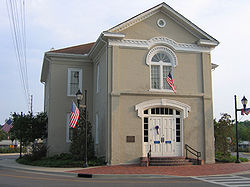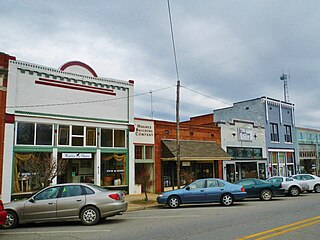
St. Stephens is an unincorporated census-designated place in Washington County, Alabama, United States. As of the 2010 census, its population was 495. Located near the Tombigbee River in the southwestern part of the state and 67 miles north of Mobile, it is composed of two distinct sites: Old St. Stephens and New St. Stephens. The Old St. Stephens site lies directly on the river and is no longer inhabited. It was the territorial capital of the Alabama Territory. Now encompassed by the Old St. Stephens Historical Park, it is listed on the National Register of Historic Places.

The Ventura County Courthouse, known since 1974 as Ventura City Hall, is a historic building in Ventura, California. It is located on a hill at the top of California Street, overlooking the city's downtown district with views of the Santa Barbara Channel and Channel Islands. It was the first building in the City of Ventura to be listed on the National Register of Historic Places and has also received historic designations at the state, county, and city levels.

Atlanta City Hall is the headquarters of the City of Atlanta government. It was constructed in 1930, and is located in Downtown Atlanta. It is a high-rise office tower very similar to dozens of other city halls built in the United States during the same time period. Located in South Downtown, it is near other governmental structures, such as the Georgia State Capitol and the Fulton County Courthouse. The Neo-Gothic structure features many architectural details that have helped to make the building a historical landmark. It is Atlanta’s fourth city hall.

Gaineswood is a plantation house in Demopolis, Alabama, United States. The house was completed on the eve of the American Civil War after a construction period of almost twenty years. It is the grandest plantation house ever built in Marengo County and is one of the most significant remaining examples of Greek Revival architecture in Alabama. The house and grounds are currently operated by the Alabama Historical Commission as a historic house museum. Construction of the house relied heavily on slave labor.
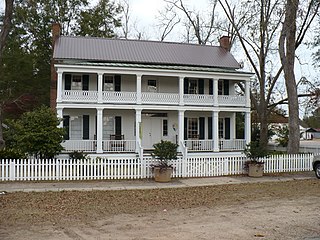
The Alston–Cobb House, now formally known as the Clarke County Historical Museum, is a historic house and local history museum in Grove Hill, Alabama. It was built in 1854 by Dr. Lemuel Lovett Alston as a Greek Revival I-house, a vernacular style also known in the South as Plantation Plain. It is one of only four examples of an I-house to survive intact in Clarke County. The Alston–Cobb House was added to the Alabama Register of Landmarks and Heritage on September 1, 1978 and to the National Register of Historic Places on April 30, 1979.

The Hawthorne House, also known as the Col. J. R. Hawthorne House, is a historic plantation house in Pine Apple, Alabama, USA. The two-story wood-frame house was built in 1854 for Joseph Richard Hawthorne by Ezra Plumb. Joseph Hawthorne was born in 1805 in North Carolina, but the family had relocated to Wilkinson County, Georgia by 1810. Hawthorne moved to Conecuh County, Alabama in the 1830s and finally settled in Pine Apple in the 1850s. He owned several large plantations in Conecuh and Wilcox counties. He died in Pine Apple in 1889. The house was sold out of the family after his death, but was brought back into the family when acquired in 1935 by Gladys Hawthorne Whitaker and her brother, Dr. Julian Hawthorne, a New York physician. They restored the house and it remained in the family until Mrs. Whitaker's death in 1980. The house was recorded by the Historic American Buildings Survey in 1937. It was purchased after the death of Mrs. Whitaker by Dr. Edward Childs of Mobile. The house was added to the Alabama Register of Landmarks and Heritage on November 9, 1992 and to the National Register of Historic Places on March 7, 1985 with the name of Hawtorn House.

The Nicholas Gotten House is located on 2969 Court Street in Bartlett, Tennessee, United States. It houses the Bartlett Museum, a local history museum operated by the Bartlett Historical Society.

The Carroll County Courthouse is a historic county courthouse located at Hillsville, Carroll County, Virginia. It was built between 1870 and 1875, and is a two-story brick building with a gable roof. It features a two-story, pedimented portico in the Doric order. The building is topped by an octagonal cupola. The courthouse was the scene of the famous Hillsville massacre of March 14, 1912, in which five persons, including the presiding judge, were killed in a courtroom battle.

The Wilson–Finlay House, also known as Mist Lady, the Joshua Wilson House, and the Finlay House, is a historic plantation house in Gainestown, Alabama. It was added to the Alabama Register of Landmarks and Heritage on September 17, 1976. It was placed on the National Register of Historic Places on July 12, 1978, due to its architectural significance.

The St. Stephens Courthouse, listed on the National Register of Historic Places as the Washington County Courthouse and also known as the St. Stephens Masonic Lodge, is a historic former courthouse building in St. Stephens, Alabama. The Alabama Legislature authorized construction of the building in 1853 to serve as headquarters for the government of Washington County. The building was completed in 1854 and served as the county courthouse until 1907, when the county seat was moved to Chatom. It served a variety of purposes after that, until being restored in 2000 by the St. Stephens Historical Commission for use as a visitor center and local history museum.

Aduston Hall is a historic antebellum plantation house in the riverside town of Gainesville, Alabama. Although the raised cottage displays the strict symmetry and precise detailing of the Greek Revival style, it is very unusual in its massing. The house is low and spread out over one-story with a fluid floor-plan more reminiscent of a 20th-century California ranch house than the typically boxy neoclassical houses of its own era.

Shelby is a census-designated place and unincorporated community in Shelby County, Alabama, United States. Its population was 1,044 as of the 2010 census. The area is near Lay Lake and Waxahatchee Creek. Shelby Iron Park is located at the heart of the area. Two sites in Shelby, The Brick House and the Old Shelby Hotel, are listed on the Alabama Register of Landmarks and Heritage.

Oakhurst, also known as Winston Place and Mitchell Place, is a historic house in Emelle, Sumter County, Alabama. The two-story wood-frame house was built for Augustus Anthony Winston, a banker and cotton factor from Mobile, in 1854. The Greek Revival-style structure is five bays wide, with a one-story porch spanning the entire width of the primary facade. A bracketed cornice atop the entablature wraps around the entire house. It reflects the influence of the Italianate-style. This architectural combination, sometimes referred to as a "bracketed Greek Revival" style, was popular in Alabama from the 1850s to 1890s.
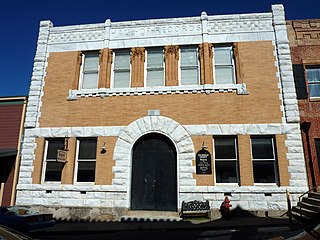
The Calaveras County Courthouse is a historic courthouse building in San Andreas, California. The brick courthouse was built in 1867 and contained the county's courtroom, jail, and sheriff's office; until 1888, executions were also conducted in the building. The county's Hall of Records was built in front of the courthouse in 1893; the two buildings nearly touch and are considered part of the same complex. The building's jail held outlaw Black Bart, a notorious Northern California highwayman, during his 1883 trial. In 1966, the county moved its courthouse to a new building; the old courthouse is now the Calaveras County Museum, which is operated by the Calaveras County Historical Society.

Fourmile, also known as Redlawn, is an unincorporated community in Shelby County, Alabama, United States. Fourmile is located 4 miles (6.4 km) northeast of Columbiana and 3 miles (4.8 km) west of Wilsonville. Some of the early settlers of Fourmile came from Lexington County and Newberry County, South Carolina.

The Old Iroquois County Courthouse, now known as the Iroquois County Museum, is a history museum in Watseka, Illinois, which served as the Iroquois County courthouse from 1866 until 1964. The Italianate building was designed by C.B. Leach and built by contractor A.C. Mantor. In addition to housing county courts and offices, the building also served as the county jail and sheriff's residence. In 1881, an addition was placed on the building, and the courthouse's octagonal tower was replaced by a square tower. A second addition was constructed in 1927; in the same year, the courthouse's copper dome was removed and replaced by a mansard roof.
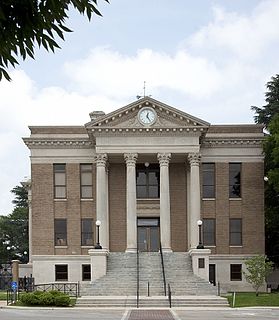
The Athens Courthouse Square Commercial Historic District is a historic district in Athens, Alabama. Athens was founded in 1818 when Robert Beaty and John D. Carroll began selling tracts of land. The following year, the town was chosen as the county seat of the newly formed Limestone County. Commercial development around the courthouse square was swift, aided by the strong cotton market. The town and courthouse suffered heavy damage during the Civil War in the Battle of Sulphur Creek Trestle. Athens' revival was slowed by major fires in 1882, 1894, and 1897, as well as the Panic of 1893. Redevelopment was spurred again in the 1910s and 1920s by a diversified economy with increased manufacturing, and in the 1930s by electricity provided by the Tennessee Valley Authority. Notable buildings in the district are the Limestone County Courthouse, built in 1919 in Neoclassical style with Palladian influences. The Old Post Office building was completed in 1933. The district was listed on the National Register of Historic Places in 1997 and the Alabama Register of Landmarks and Heritage in 2012.
